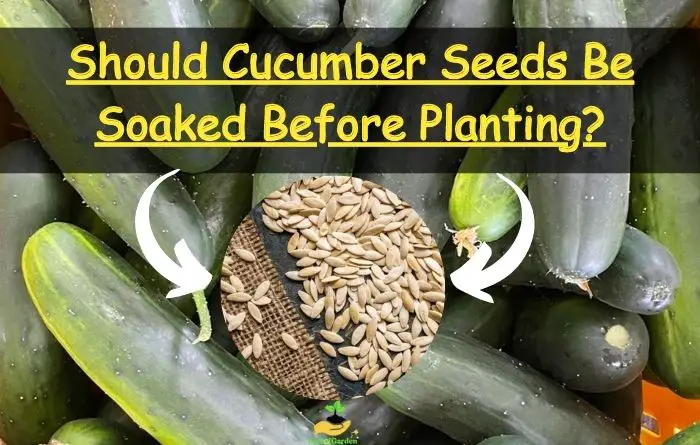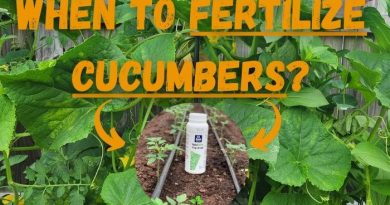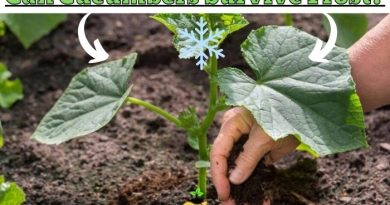Soaking Cucumber Seeds before Planting: The Pros And Cons!
Many gardeners often find themselves wondering whether or not it’s necessary to soak cucumber seeds before planting them. As I faced this dilemma myself I understand the frustration that arises from opinions. In this article, we will delve into the advantages and disadvantages of soaking cucumber seeds before planting and provide practical suggestions on how to do it efficiently.
Soaking cucumber seeds before planting can be beneficial for improving germination rates and seedling vigor. It is recommended to soak seeds just before planting using clean, lukewarm water for no more than 12–24 hours. However, it is important to research the specific seed variety and consult with a gardening expert before deciding whether to soak cucumber seeds.
| Characteristic | Details |
|---|---|
| Seed Type | Cucumber |
| Seed Age | Fresh (less than 5 years old) |
| Water Temperature | Lukewarm (around 70-75°F) |
| Soaking Time | 12-24 hours |
| Water Quality | Clean and free of contaminants |
| Seed Quantity | 1-2 tablespoons of seeds per quart of water |
| Frequency | Just before planting |
| Additional Tips | Stir the seeds occasionally while soaking to ensure even water absorption |
Benefits of Soaking Cucumber Seeds
1. Improves Germination Rates
Soaking cucumber seeds before planting has a benefit in improving the rate at which they germinate. Cucumber seeds have a layer that can stop water absorption, causing a delay in germination.
By soaking your cucumber seeds, this dormancy is broken, allowing water to penetrate the seed coat and initiate germination quickly and uniformly.
2. Enhanced Seedling Vigor
Not only does soaking cucumber seeds result in better germination, but it also leads to stronger and more vigorous seedlings.
The process of soaking triggers the activation of enzymes and nutrients within the seed, providing a burst of energy for the emerging seedlings.
This translates into growth and sturdier stems. This advantage becomes particularly valuable when transplanting your cucumber seedlings into the garden as they are better equipped to handle stress.
3. Improves disease resistance
Another benefit of soaking cucumber seeds is disease prevention. Gardeners often face the risk of soil-borne diseases that can harm seedlings.
By soaking cucumber seeds in water any potential pathogens clinging to their surfaces are washed away during the process. Additionally, soaked seeds develop into seedlings with a defense system making them less vulnerable to disease attacks.
Drawbacks of Soaking Cucumber Seeds
1. Increased risk of disease
One of the disadvantages of soaking cucumber seeds is the chance of disease occurrence. When seeds are soaked in water it creates a moist environment that’s perfect for pathogens like fungi and bacteria to thrive.
This can lead to the spread of diseases. Weaken the vigor of seedlings. To prevent this, it’s crucial to use water when soaking seeds and include a disinfectant, like hydrogen peroxide in the soaking solution. Additionally, make sure to dry the seeds before planting them to hinder pathogen growth.
2. Damage to Cucumber Seeds
Another potential drawback of soaking cucumber seeds is that it can harm the seeds themselves. If they are soaked for a long or exposed to hot water, it can damage their protective outer layer and reduce their viability.
Cucumber seeds are delicate, and rough handling during soaking can cause harm to their layer. This compromises their coat making them susceptible, to infections and decreasing germination rates.
Unless handled with care these seeds may lose their natural defense mechanisms. Struggle once planted in soil. To avoid this issue, limit the soaking time to 12–24 hours using water. Afterward, ensure thorough drying before planting to maintain seed integrity and maximize viability.
In addition to the potential drawbacks of soaking cucumber seeds, it is important to note that not all seed varieties will benefit from soaking. Some seeds, such as those with thin seed coats, may not require soaking and may actually be harmed by the process.
Here are some cucumber seed varieties that I researched to determine if they benefit from soaking.
Table with cucumber seed varieties that may benefit from soaking:
| Cucumber Seed Varieties |
|---|
| Long English cucumbers |
| Armenian cucumbers |
| Lemon cucumbers |
| Pickling cucumbers |
| Burpless cucumbers |
| Slicing cucumbers |
https://www.allaboutgardening.com/cucumber-varieties/
When to Soak Cucumber Seeds
When it comes to soaking cucumber seeds the timing is crucial. It’s important to consider when exactly to soak them as doing so early or too late can result in outcomes. Generally, it’s best to soak the cucumber seeds right before you plant them.
If you soak the seeds early their viability may decrease. This means that if they are soaked well in advance of planting they might start germinating or get damaged. In order to prevent this I suggest that you soak the seeds for no more than 12 to 24 hours before you actually plant them.
Otherwise, if you wait too long to soak the seeds and skip this step before planting they might take longer to germinate or have weaker seedling growth. To avoid these issues it is advisable to soak the seeds before planting them.
How to Soak Cucumber Seeds before Planting

Here’s a simple step by step guide to effectively soaking cucumber seeds:
Step 1: Prepare everything you need
Before you start make sure you have everything you need. You’ll need cucumber seeds, a container and water at room temperature. Make sure the container is big enough for the seeds without overcrowding.
Step 2: Choose the right seeds
Select high quality cucumber seeds from a trusted source. If you’re using saved seeds from your cucumbers make sure they are fully mature, disease free, properly dried and stored.
Step 3: Measure the amount of seeds
Try to measure the quantity of cucumber seeds you intend to soak. This will ensure that you have the amount for your planting needs.
Step 4: Soak the cucumber seeds
Put the cucumber seeds into the clean container. Add room temperature water to completely cover them. Ensure that the water level is at an inch above the seeds to allow for proper absorption.
Step 5: Set a timer
Allow the seeds to soak for 12 to 24 hours. It’s best not to exceed this time frame as it can lead to soaking and potential damage, to the seeds.
Step 6: Monitor the Seeds
During the soaking period make sure to keep an eye on the seeds. You may notice that some of them start to expand as they absorb water.
Step 7: Remove the Water
Once the soaking time is over carefully drain the water from the container. You can use a fine mesh strainer. Pour out the seeds and water into a colander.
Step 8: Planting the Seeds
After draining it’s time to plant the seeds. Follow the recommended planting depth. Spacing for cucumber seeds in your garden or containers.
Step 9: Maintain Records
Remember to keep track of which seeds you soaked and note down the date of soaking. This will help you monitor how effective this process is and make any adjustments, for future plantings.
Alternative Cucumber Seed Treatment Methods before Planting
Instead of relying solely on soaking, gardeners can explore alternative seed treatment methods that offer similar benefits without the risks. Two common alternative seed treatment methods are scarification and stratification.
Here is a comparison table between soaking, scarification, and stratification:
| Seed Treatment Method | Benefits | Suitable Seeds | Suitable Growing Conditions |
|---|---|---|---|
| Soaking | Improves water absorption | Cucumber seeds saved from previous harvests. | Warm and moist growing conditions |
| Scarification | Breaks down hard seed coat, improves water absorption | Cucumber seeds with hard/thick coats. | Warm and moist growing conditions |
| Stratification | Breaks dormancy, promotes germination | Cucumber varieties with dormancy needs. Late fall or early winter planting. | Cold and moist growing conditions |
1. Scarification
Scarification is a method used before planting seeds, where the outer coating of the seed is gently scratched or nicked to facilitate water absorption.
This technique can be advantageous for cucumber seeds that have tough or thick coats as it allows water to penetrate the seed more easily breaking dormancy and encouraging germination.
Some types of cucumber seeds, heirloom varieties or ones saved from previous harvests may find scarification beneficial.
When you Should Consider Scarification
It is worth considering scarification for cucumber seeds with thick coats especially if you notice that these seeds tend to have a slower germination rate compared to others.
If you are using cucumber seeds or seeds saved from your own cucumbers scarification can also serve as an effective alternative, to soaking in order to promote better germination.
2. Stratification
Stratification is a method used before planting where seeds are exposed to moist conditions simulating the natural winter environment.
This technique is especially beneficial for types of cucumber that have a dormancy requirement and need exposure to cold temperatures to overcome it.
When you Should Consider Stratification
You should consider stratification, for cucumber seeds that specifically require treatment.
If you’re planning to grow cucumber varieties that typically thrive in climates or if you’re sowing seeds during late autumn or early winter stratification can be a useful approach to ensure successful germination under optimal growing conditions.
Conclusion
In conclusion, soaking cucumber seeds before planting proves to be a valuable practice with numerous benefits. Through this blog post, we’ve learned that soaking enhances germination rates and fosters healthier seedlings, setting the stage for a thriving cucumber garden.
While soaking cucumber seeds before planting is a widely practiced gardening technique, it is essential to be aware of the potential drawbacks associated with this method.
As you embark on your gardening journey, I encourage you to give this seed treatment method a try. Remember to soak the seeds 12-24 hours before planting, ensuring they have ample time to absorb water and break dormancy without any adverse effects.
I’m eager to hear about your experiences with soaking cucumber seeds.
Frequently Asked Questions
It is not recommended to reuse the water used for soaking cucumber seeds, as it may contain contaminants or pathogens that can harm the seeds or plants. It is best to use clean, fresh water for each soaking session.
Yes, soaking cucumber seeds for too long can cause them to become waterlogged and reduce germination rates. It is important to follow the recommended soaking time for the specific seed variety and growing conditions.
The best water temperature for soaking cucumber seeds is lukewarm, around 70-75°F. This temperature range helps to promote water absorption without causing the seeds to become too warm or cold.




